Growing up in the early 1970s, I relied on brush rollers to add curl to my straight hair. To keep them in at night, I’d used bobby pins. Sleeping on those prickly brushes had to be the most uncomfortable thing imaginable!
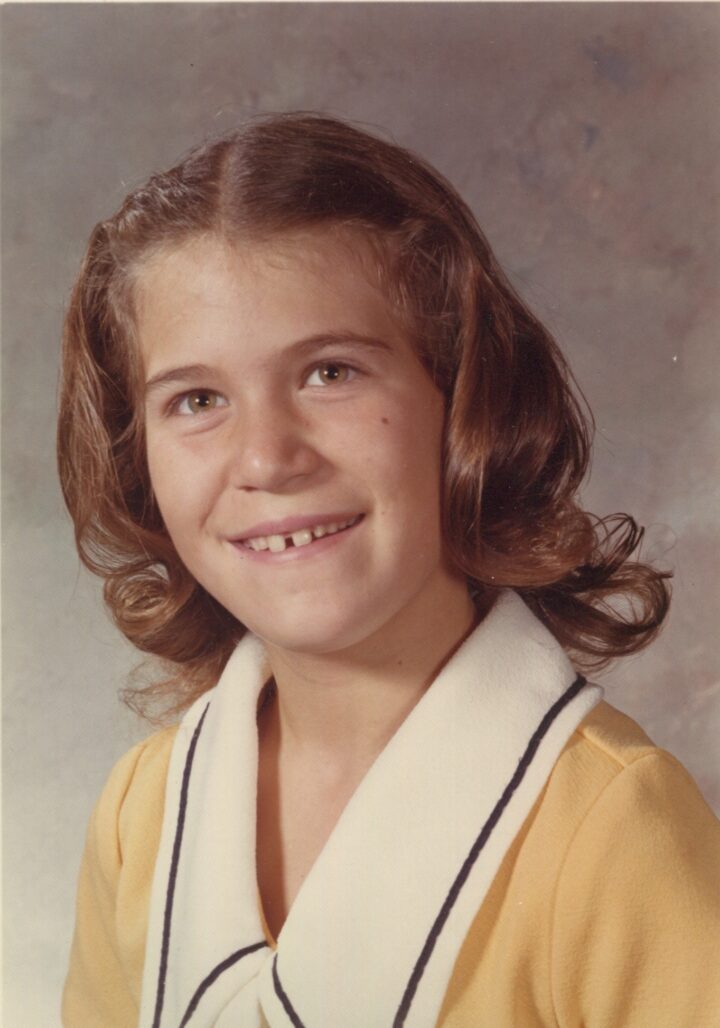
For fourth grade photo day, I still remember my mother taking out the rollers, brushing and styling my hair, and then lacquering it with Aqua-Net® hairspray. To keep my hair swept up off my forehead, she used a bobby pin and then hair sprayed the hell out of it.
I was then under strict orders to not run around or do anything to muss myself before the photo was taken! (The curl always fell out despite the vast amounts of hair spray.)
So yes, bobby pins, curlers, barrettes, clips, and even hair ribbons were all part of my childhood. I’d purchase my hair accessories at the dime store, Longs Drugstore or Woolworth’s. Once I became a teen, I cut my hair to match Olympic ice-skater Dorothy Hamill’s hair style. That ended my need for hair accessories.
Suffice to say, I hadn’t given bobby pins a thought until I began doing research on a company that had designed an old sewing kit I have. I discovered the company also manufactured bobby pins. Intrigued, I began researching in earnest and stumbled upon Sta-Rite Ginnie Lou, Inc.
R. Noel Bolinger II, the great-grandson of founder George Curns Bolinger, and now president of the company, sat down with me to talk about the history of bobby pin manufacturing, and how Sta-Rite has retained its production in-house all these years.
Their story is amazing.
Bobby pin manufacturing – a brief history

Founded in 1917, Sta-Rite first produced hair pins; following WWI, the company began manufacturing bobby pins.
Today, Sta-Rite is the only manufacturer to produce its pins in the same factory where it all started 106 years ago. In fact, it’s the only company in the United States still making bobby pins. Amazing.
Based in Shelbyville, IL, a small town south of Champaign, Sta-Rite first patented a hair pin made from celluloid — a trademark for a colorless or ivory colored substance that consists of pyroxylin and camphor.
The company developed the patent for a wire hair pin 1921. Used in hair styles of the time, when women’s long hair was swept up into chignons, pompadours, and other up-dos, the wire hair pins were easy to use, and most importantly, stayed in the hair.
During the 1920’s (or after WW1) hair styles changed dramatically when women began cutting or bobbing their hair. Short hair necessitated a different type of pin.
An LA Times obituary credits Luis Marcus, a native of Winnipeg, Manitoba, with inventing the bobby pin. According to his daughter, he considered naming it the Marcus Pin but settled on the bobby pin based on the bobbed hair style. (All source links below.)
“Sta-Rite also produced a bobby pin,” says Mr. Bolinger. “In fact, we designed and patented several types of bobby pins, including flat bob, ringlet curl, and glare-proof bob pins. Over time, ten to fifteen companies were producing bobby pins in the U.S., including Morris-Flamingo and Gayla.”
In this 1935 price card, you can see the difference between the different types of hair pins and bob pins.
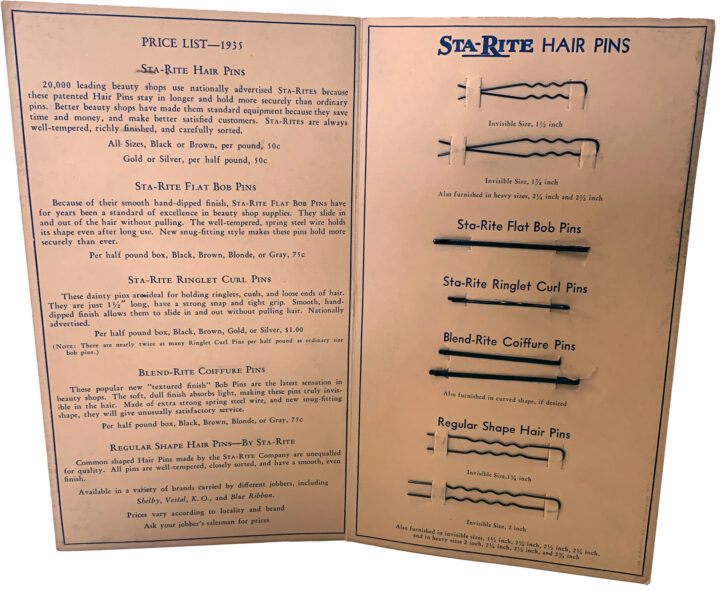
Morris-Flamingo
The Morris-Flamingo brand of bobby pins still exists, but the brand is one of over 45 owned by The Stephen Company, a privately-owned distributor of barber, beauty, and personal care items. The Stephan Company paid $3.7M in stock and assumed $1.9M in debt for the ailing manufacturer in 1998.
According to Mr. Bolinger, Morris-Flamingo’s founders, Ray Girouard and Chuck Himan, worked at Sta-Rite for a time before starting their own company.
Gayla
Located in Chicago, IL, Gayla manufactured the Hold-Bob bobby pin. Although no longer in business, the buildings still stand, according to Mr. Bolinger.
And, you can still purchase vintage Hold-Bob pin cards on eBay and Etsy. (See links below for a write-up a blogger did about a Gayla print ad she found in a magazine. Apparently, the company was first named the Hump Hair Pin Company!)
Wilson Manufacturing – plus some Sta-Rite family history
Wilson Manufacturing, founded by Hugh Wilson and his wife Mary Pich Wilson, manufactured bobby pins under the Wil-hold brand.
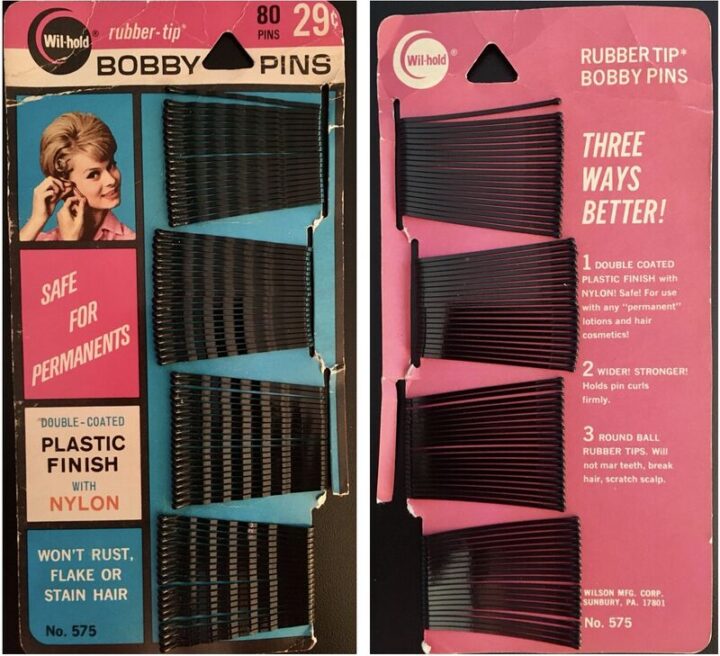
It’s due to my owning a vintage sewing box manufactured by Wilson Manufacturing that I discovered Mary Pich Wilson. In addition to designing the sewing box, she also developed a machine for improving the manufacture of bobby pins – for which she received a patent. (See the obituary link below.)
I initially thought Mary Pich Wilson, a trailblazing woman, was the story I was seeking — but I learned a surprising twist from Mr. Bolinger.
“That story is family history,” he says. “Hugh Wilson was married to Katherine Bolinger, my grandfather’s sister, and was the Sales Division Head for the company. Mary Pich was his assistant. When Hugh and Katherine moved to New York, Mary followed them. At some point, they divorced and Hugh married Mary Pich.”
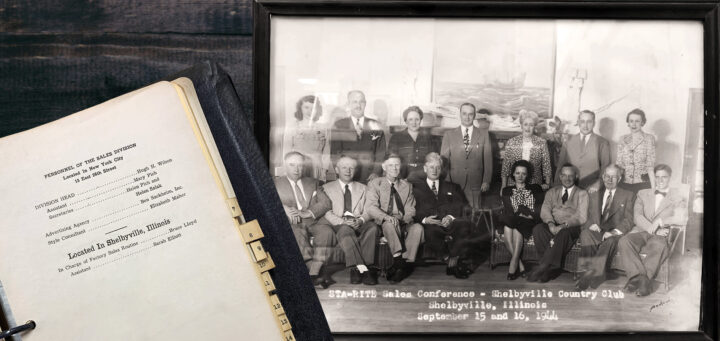
Right: 1944 Sales Conference: G. Noel Bolinger (back row, second from right), Hugh Wilson (back row, center), and Mary Pich (front row, black dress). Images provided by and © Sta-Rite Ginnie Lou, Inc.
Sta-Rite: Still producing bobby pins in Shelbyville
The process for creating bobby pins is relatively straight-forward. Pins are formed using round wire, which Sta-Rite sources from the United States and Germany. “We have purchased wire from China in the past,” notes Mr. Bolinger.
The wire is flattened and then fed into the machine, which crimps, cuts, and bends the pin in half. Pins are put on a belt, sent through the paint oven, and then tipped – meaning a rubber tip is added to the two ends of the pin.
Once the pins are finished, they’re packed up in in jugs or boxes. They’re also added to cards by hand.
Rubber tips — an important improvement
A NY Times obituary credits Nat L. Solomon with inventing the rubber tips in the 1940s in response to dentists complaining about women chipping their teeth when using them to open the pins.
Mr. Bolinger, however, doesn’t remember it this way. “Rubber tips were added to keep the metal ends from scratching women’s scalps,” he says. “We began adding them in 1951 or ’52.”
His daughter, and company VP Julia Bolinger, confirmed the company was adding rubber tips by the mid 1950s, but couldn’t find any earlier pin cards. She and I also reviewed Nat Solomon’s many patents, but couldn’t find one specific to adding the rubber tips.
Ms. Bolinger did find another bobby pin patent, however, filed by Samuel Tick, Toronto, Ontario, Canada. Patent date is Nov. 29, 1949.
The patent specifically states that the invention is to prevent the chipping of teeth by “providing a bobby pin having its outer ends or tips coated with a soft or relatively soft substance or such substance as will not abrade or otherwise cause injury to the teeth.”
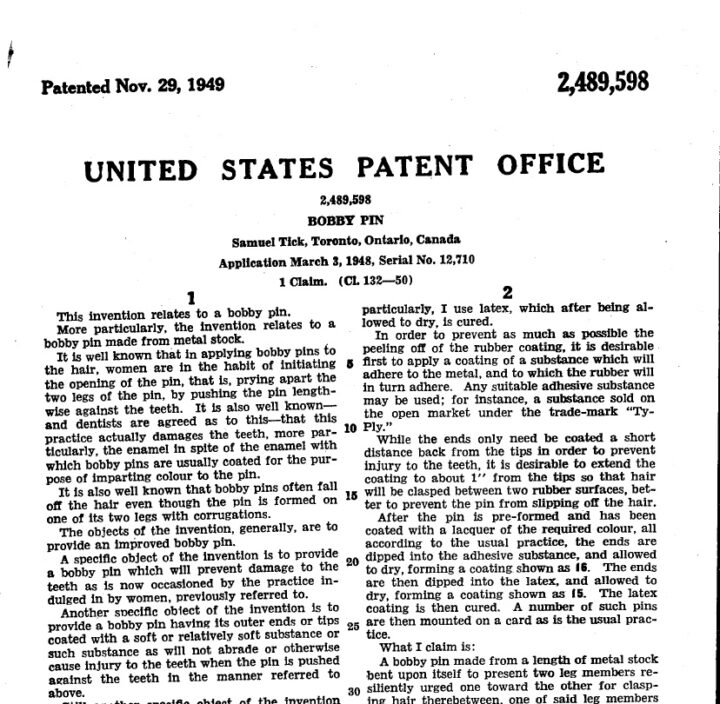
What keeps Mr. Bolinger manufacturing in the U.S.
Given that to the average person, all bobby pins look the same, what makes Sta-Rite’s different?
“You can pull the Sta-Rite pin further part and have it snap back into shape,” said Mr. Bolinger.
I actually tested this using three pins: Sta-Rite, Wil-hold vintage, and a Conair® brand Made in China. The latter two didn’t bounce back the way the Sta-Rite pin did.
It’s also interesting to note the design differences with each pin, especially the end tips and the crimps.
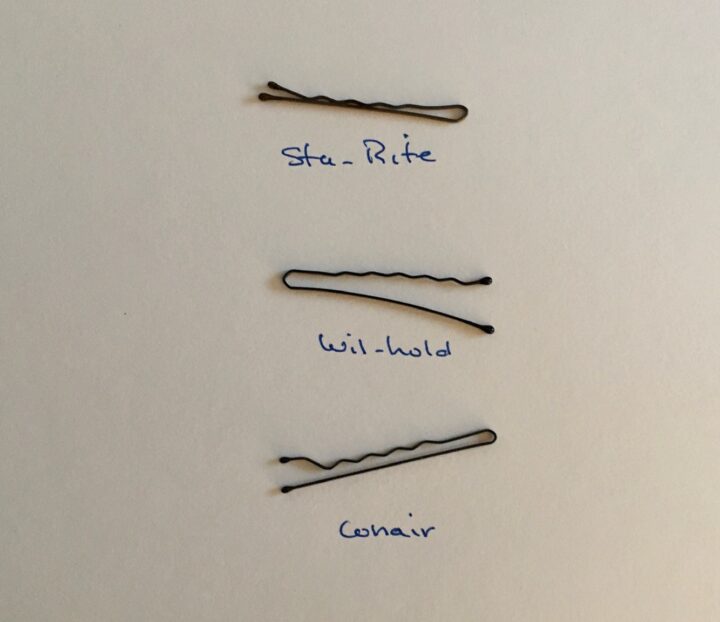
When asked what has inspired him to keep manufacturing in the United States, Mr. Bolinger replied, “It’s something I enjoy doing – and it’s been interesting. Keeping manufacturing in the U.S. has given us advantages and disadvantages. Our turn-around is better; we can make a large order of pins and ship within a week versus waiting three months for them to arrive from China.
“However, pricing is sometimes tough. We used to sell to over 5,000 Sally Beauty Supply stores in the U.S., but they went to China. We still sell to Sally Beauty in Mexico.”
As to the company name, where does the Ginnie Lou come in? “Virginia was my grandmother’s name,” replied Mr. Bolinger. My grandfather added her name to the official company name.”
The company produces hair pins, bobby pins, roller pins, hot roller clips, and switch pins. Other products, such as combs, are sourced from companies that manufacture in the U.S. Other products are imported.
Thank you, Mr. Bolinger and Julia Bolinger, for your time. You have an amazing story! I’m thrilled you shared it with me and my readers!
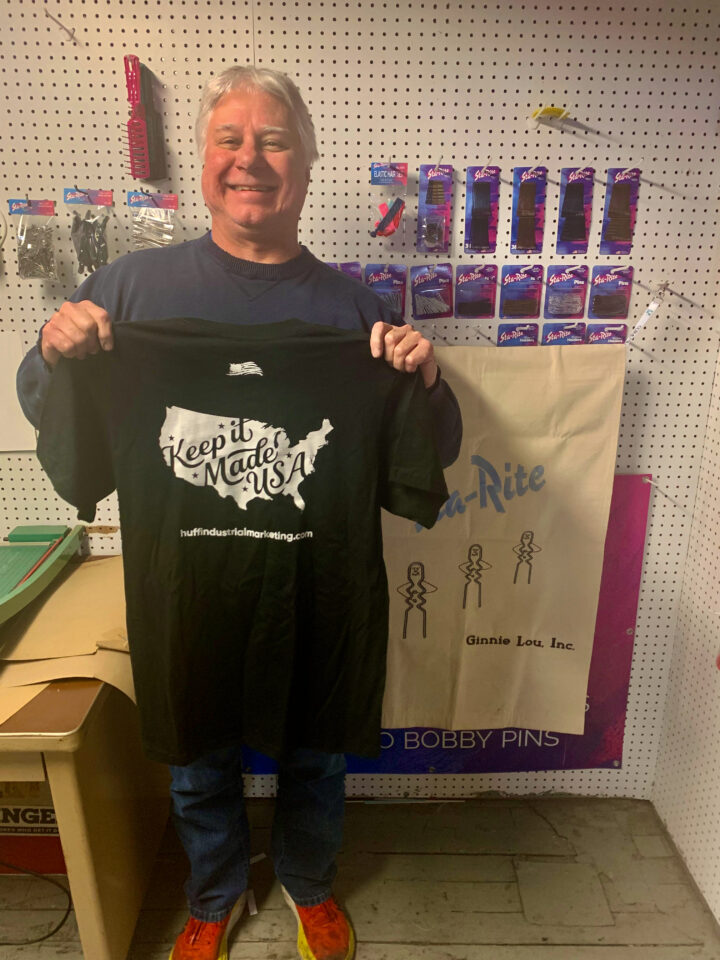
Post Script
As a way to say thank you to people for their time in sharing their stories, I’ve begun sending t-shirts.
The shirts are made in the USA by Authentically American (link below). Here’s Mr. Bolinger proudly holding his. Woot! Looking good, sir!
Get the Keep It Made USA newsletter.
Twice monthly; zero spam.
Source Links
Sta-Rite Ginnie Lou — All Sta-Rite products can be purchased from the company’s website – and each product description lists if it’s Made in the U.S.
Vintage Goody Brush Rollers – eBay
LA Times, Luis Marcus obituary
The Vintage Traveler blog: Hold-Bob Bobby Pins
Newspapers.com: Mary Pich Wilson obituary
NY Times, Nat L. Solomon obituary
Scanned document: Samuel Tick, Bobby Pin Patent
Authentically American — Read the interview
Full Disclosure
I’m not paid nor asked to write about products or the companies that make them. All links in this piece are FREE — meaning, they’re not sponsored or paid for.
My mission is to keep manufacturing jobs stateside and this blog is my way of giving back. We like to think a “small” choice, such as purchasing something made in the US by American workers, won’t make a difference. It does.
